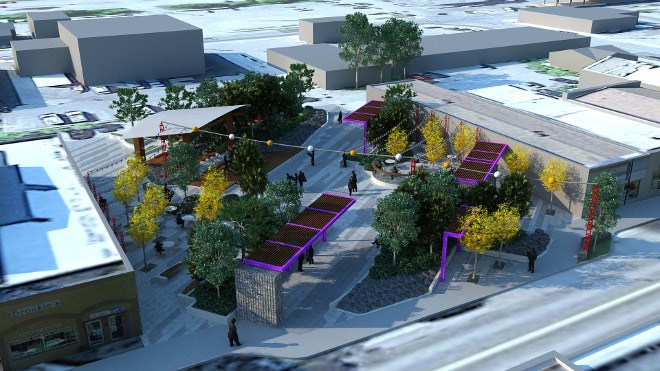By next summer, Fort Frances could have a new market square that will reflect the landscape and history of the region, while serving multiple purposes.
Last January, the town hired Scatliff + Miller + Murray, headquartered in Winnipeg, Man., to design a square on the site of the former Rainy Lake Hotel.
Built in 1928 in the Spanish Revival architectural style, the 12,000-square-foot hotel had served as a social hub for the town until it closed just over a decade ago.
With no prospects for redevelopment on the horizon, JMX Contracting was awarded a nearly $600,000 demolition contract and took the building down in October, 2015, leaving a large, empty footprint in the town’s centre core.
That’s when Scatliff + Miller + Murray got to work.
In early 2016, the architectural firm held two public consultation sessions to gather public input, said David Bodnarchuk, a landscape architect with the firm.
“That helped us put together a punch list of all the things that people wanted to see happen there,” he said. “Ultimately, in the end, I think most of the public requests were accommodated in one way or another.”
A key goal of the project was to “create a place that spoke to the region,” Bodnarchuk said.
A border town that attracts American visitors who may be unfamiliar with the area, Fort Frances has unique natural attributes and cultural touchstones that the firm wanted to highlight.
“Fort Frances is a unique place,” Bodnarchuk said. “It’s where the great plains meet the Canadian Shield. If you go a little bit south, you’re into flat prairie land almost, and if you go to the north or the east, you’re into more rugged Canadian Shield. It’s a transition zone, and so we wanted to draw from that.”
The square will feature a covered stage for concerts and performances, as well as an open area where tents can be set up for a farmers market.
Intimate seating areas with moveable furniture will abut the stage, and room has been left open where small cafés or restaurants could be set up in the future.
Light towers installed on either side of the square mimic the hydro transmission towers that dot the area’s landscape for a “playful way of setting the stage and reminding people that this is what it feels to be in this area,” Bodnarchuk said.
Panels installed in the towers will even allow artwork to be displayed publicly.
As to the square’s natural features, designers employed a paving pattern reflective of markings in local rock that were created by glaciers dragging across the land. Islands will be planted with Boreal trees and shrubs “so that it looks and feels really natural,” Bodnarchuk added.
Key in the design, he said, is versatility. “We really wanted things to be able to change and adapt to whatever is going on there,” Bodnarchuck said.
“And so if somebody just wants to go through and sit quietly and read a book, there will be a place for that. And if they want to gather with 10 friends, there will be a place for that. And if they want to have an event with 300 people there will be a place for that, too.”
Currently, the $1.4-million project is at a standstill while requests for government funding are reviewed; additional funding sources include the Town of Fort Frances, the Business Improvement Area, and local organizations.
Bodnarchuk said if capital comes through this fall, the firm will complete the drawings by winter.
After that, a tender will be issued for construction work, in time for ground to be broken in the spring, and the square could then be complete later next summer.
This project holds a special place for Bodnarchuk, who was born and raised in Fort Frances and continues to visit regularly.
He believes the market project will inject a new vibrancy into the town’s heart, and act as a catalyst for boosting economic development activity.
“This is the downtown Scott Street strip, so the more people that are down here the healthier that central business district will be,” Bodnarchuk said. “I think, no matter how you slice it, it will be a benefit for those businesses along that street and it will be a good thing for the entire community.”






